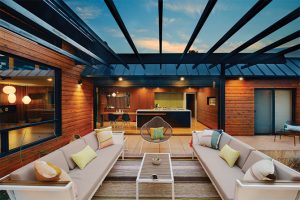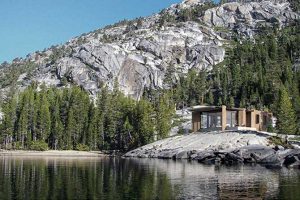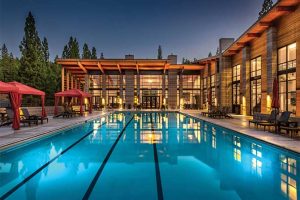By AIA Northern Nevada
CITATION
Architect: Van Woert Bigotti Architects
Contractor: Core Construction
Completion date: 2019
Location: Reno, Nevada
Design Goals:
For this new Middle School, the District set out optimistic goals to provide the community a prototype design that is sustainable, safe, flexible, functional, maximizes natural daylight and beats the relative cost per square foot of current trends and those seen in the previous “traditional-schools.” At a time where costs in the area exceed $335.00 per square foot, the District’s budget restraint called for strategic design. A simple arrangement of program components was required to offer ease of construction, transformation for future site adaptability, and ease of wayfinding. Equally important to the District was to evoke imagery for a renewed interest in school pride through quality interiors and architectural identity.
Design Approach:
The design is an adaptable “kit of parts” solution organized by a main street corridor. Separate wings surround an outdoor courtyard with outdoor learning sub-courts. Grade levels are individually paired as “Schools within a School”; sixth grade with Electives and seventh grade with eighth grade in separate two-story wings with Team Teaching spaces for each grade level. The central wing accommodates the Main entrance(s), Administration and the Media Center. The “main street,” monitored by the school office, organizes the building parts. It is the main conduit of the school. It includes inspirational wall words representing the acronym S.T.R.O.N.G. (Significant, Tolerant, Resilient, Noble and Grateful), each of which are team names that students are assigned. These words are placed throughout the main street to support these student teams to create team pride and school unity. Collectively, the building acts as a campus yet functions as one facility. Separating seventh and eighth grades in one wing and sixth grade and electives in another directly respond to the District’s brief to address age differences. To address the strict budget constraints, the design team set out to create simple construction systems by applying an “economy of means” building approach. A repetition of concrete masonry walls uninterrupted from the ground to a parapet, alternating with glass curtain walls, provided expedient construction measures, as well as rhythmic composition for aesthetics. Metal panel volumes highlight programmatic areas for architectural interest and school colors and identity. This simple construction methodology on the majority of the building allowed for the hierarchical treatment of the centralized entry wing (including the main single-point entry, library, the student entrance from the outdoor commons space). For this element, an expressive simple framed inverted roof celebrates the importance of function and offers a unique school identity.
Interior architecture strategies carry out a vibrant color palette, wayfinding methods, graphics, and a school mural unique to Desert Skies. These strategies are intended to inspire and activate the students and staff to generate motivation for teaching and learning and school pride.
The design is also responsive to the District’s wish to have the building act as a learning tool. The team incorporated the concepts of an exposed mechanical room at the west end of “main street,” exposed mechanical piping routes and exposed structural systems. A learning component is incorporated. The mechanical room includes a computer and monitor that faces “main street” to display real-time heating and cooling data, electrical supply and demand and diagrams of how the school HVAC system is designed to function. This system is accessible to all the science and math classrooms for teaching applied concepts.
The District’s intent to make this a facility that contributes to the community was addressed by developing the cafeteria into a stage and performance space and creating the east courtyard as an amphitheater for outdoor events. The entire design was approached with the focus on maximizing expenditure to provide the necessary programmatic requirements with aesthetics that build school pride and community respect for the tax dollars invested. The cost-efficient strategies resulted in a construction cost of 25% less than that allocated for the project with no cut in program space.
The Cost.
Spending education tax dollars efficiently is evident in the actual building construction cost of $304.00 per square foot instead of the current trend in the area upward of $335.00. Cost strategies offset with aesthetic sensibility resulted in over 10% savings (with no program cuts required).
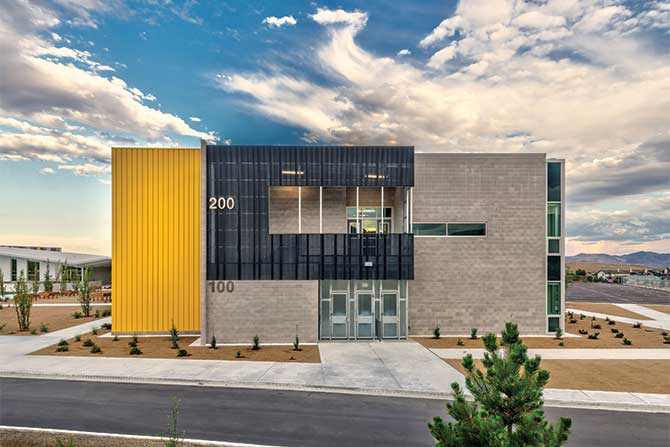
Sustainable Design Intent and Innovation:
The school is intended to be an energy-efficient, high-performance school. The goals set forth by the School District seemed challenging if not impossible: in summary, the School District set out to build its first facility that would utilize under half the energy of their typical middle school, increase the academic performance of the students, improve indoor air quality, safety, and comfort and set an example of environmental sensitivity; all of this with a construction cost that would not exceed that of a similar-size traditional school.
Natural light is the building’s primary source of lighting, which directly benefits daylighting techniques such as light shelves at all standard classrooms, skylights in athletic spaces and cafeteria and floor to floor windows in the media center, team rooms and main corridor. The building responds ideally to the sun’s path, oriented 20 degrees east of south to minimize heat gain. There is no boiler, chiller or cooling tower. The ground source heat pump system provides extraordinary benefits in heating and cooling the entire facility. 100% of reclaimed water for site irrigation and directing excess stormwater to the site’s adjacent wetland provides responsible reuse of water. Indoor air quality measures include operable windows in all perimeter classrooms, media center library and administration areas. These features are estimated to equate to 60% less energy than a traditional District Middle School.
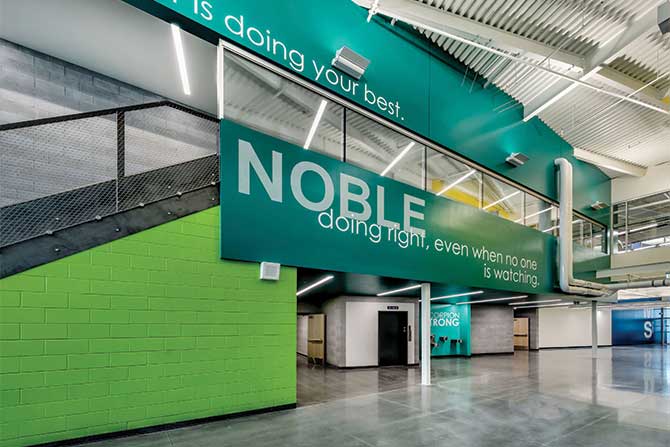
Documentation of specific material choices:
Exposed Concrete Masonry Units (CMU) structure was selected as a prominent building material to provide permanence, efficient construction strategies, virtually no maintenance, excellent structural properties, aesthetic integrity, compliance anti-terrorism, and protection against rot and mold. The greater the resilience, the lower the maintenance and reduced use of virgin materials. Also, CMU’s thermal mass and its ability to store heat and help hold conditioned spaces’ temperature can reduce energy bills and improve thermal comfort in the building.
Single-ply roofing is utilized as a positive impact on the environment. The longevity of single-ply roofing reduces waste as it is recycled during the manufacturing process and recycled once it has reached its life’s use. Removing these materials from the waste stream significantly reduces the burden on landfills and waste processing efforts. In addition to its recyclability factors, it reduces the urban heat island effect (UHI) and has a long service life. Compared to other roofing materials, less energy is needed to produce the material and process it into the end product.
Non-toxic, low VOC carpet tiles are utilized in the classrooms with a low VOC, water-based, pressure-sensitive acrylic adhesive. In other school areas, polished concrete is used to reduce maintenance and use of toxic cleaning chemicals. Low VOC’s are good for both the environment and living organisms.
The monitoring of lead content in all paints and finishes was taken very seriously. All materials, including all paint colors and metal panel coating colors underwent strict chemical lab testing with a local chemist to ensure that advertised Zero-lead content literature was validated before design team approvals during the construction process.
All plant material specified and installed meet or exceed the County’s drought-tolerant species requirement, which significantly reduces water demand.
The glass specified is a Low-E coated glass with a U-Factor of 0.28 maximum and a Solar Heat Gain Coefficient of 0.27 max. Exterior light shelves made of translucent polycarbonate material are incorporated to extend light further into the classrooms, reducing each room’s electrical demand. In addition, an operable window is included in all teaching spaces located on the perimeter of the building.






